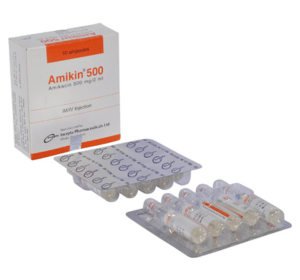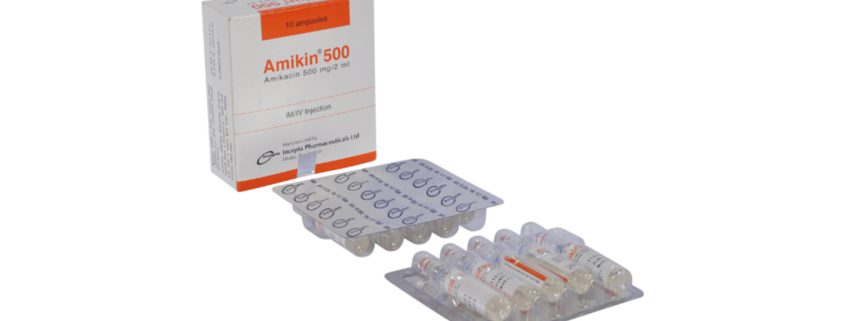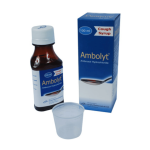Amikin(Amikacin)

Therapeutic Group: Anti Bacterial
Presentation
Amikin 100 IM/IV injection: Each 2ml ampoule contains 100 mg Amikacin (as Amikacin
Sulfate BP).
Amikin 500 IM/IV injection: Each 2ml ampoule contains 500 mg Amikacin (as Amikacin
Sulfate BP).
Description
Amikacin Sulfate is a semi-synthetic aminoglycoside antibiotic. Amikacin is active in vitro against Pseudomonas species, Escherichia coli, Proteus species, Providencia species, Klebsiella-Enterobacter species, Acinetobacter species, and Citrobacter freundii. When strains of the above organisms are found to be resistant to other aminoglycosides, including Gentamicin, TobrAmykin and KanAmykin, many are susceptible to Amikacin. Amikacin sulfate is active in vitro against penicillinase and nonpenicillinase-producing Staphylococcus species including methicillin-resistant strains.
Indications
Amikacin is indicated in the short-term treatment of serious infections due to susceptible strains of Gram-negative bacteria. It is effective in bacterial septicemia (including neonatal sepsis); in serious infections of the respiratory tract, bones and joints, central nervous system (including meningitis) and skin and soft tissue; intra abdominal infections (including peritonitis); and in bums and post operative infections (including post-vascular surgery). Amikacin is also effective in serious complicated and recurrent urinary tract infections due to susceptible Gram-negative organisms. It may be considered as initial therapy in suspected Gram-negative infections and therapy may be instituted before obtaining the results of susceptibility. Amikacin is also effective in infections caused by Gentamycln and/or TobrAmykin resistant strains of Gram-negative organisms. Amikacin has also been shown to be effective in Staphylococcal infection and may be considered as initial therapy under certain condition in the treatment of known suspected Staphylococcal disease such as, severe infections where the causative organism may either a Gram-negative bacterium or Staphylococcus infection due to susceptible strains of Staphylococcal I Gram-negative infections. In certain severe infections such as neonatal sepsis, concomitant therapy with a penicillin type drug may be indicated because of the possibility of infections due to Gram positive organism such as streptococci or pneumococci.
Dosage & Administration
Adults and children: 15mg/kg/day in two equally- divided doses (equivalent to 500 mg bid in adults). Use of the 100 mg/2 ml strength is recommended for children for the accurate measurement of the appropriate dose.
Neonates and premature children: An initial loading dose of 10 mg/kg followed by 15 mg/kg/day in two equally divided doses.
Elderly: Doses should be adjusted under impaired renal function in elderly.
Life-threatening infections and/or those caused by pseudomonas: The adult dose may be increased to 500 mg every eight hours but should neither exceed 1.5 gm/day nor be administered for a period longer than 10 days. A maximum total adult dose of 15 gm should not be exceeded.
Urinary tract infections (Other than pseudomonal infections): 7.5 mg/kg/day in two equally divided doses (equivalent to 250 mg bid in adults).
Impaired renal function: In patient with impaired renal function the daily dose should be reduced and/or the intervals between doses increased to avoid accumulation of the drug. Simple doses schedule for renal impairment is given below:
Renal function Dosage schedule
Mild impairment 500 mg every 18 hours
Moderate impairment 500 mg every 24 hours
Severe impairment 250 mg every 24 hours.
Administration:
Intramuscular or intravenous administration: For most infections the intramuscular route is preferred, but in life threatening infections, or in patients in whom intramuscular injection route is not feasible the intravenous route may be used.
Intraperitoneal use: Amikacin may be used as an irrigant after recovery from anesthesia in concentration of 0.25%.
Other routes of administration: Amikacin in concentration of 0.25% may be used satisfactorily as an irrigating solution in abscess cavities, the pleural space, the peritoneum and the cerebral ventricles.
Side Effects
When the recommended precautions and dosages are followed the incidence of toxic reactous, such as tinnitus vertigo, and partial reversible or irreversible deafness, skin rash, drug fever, headache, paraesthesia, nausea and vomiting is low. Urinary signs of renal irritation, azotaemia and oliguria have been reported.
Precautions
Since Amikacin is present in high concentrations in the renal excretory system, patients should be well hydrated to minimize chemical irritation of the renal tubules. If azotemia increases, treatment should be stopped. Monitoring of renal function during treatment with aminoglycosides is particularly important.
Use in Pregnancy & Lactation
The safety of Amikacin in pregnancy has not yet been established. It is not known whether this drug is excreted in human milk. As a general rule, nursing should not be undertaken while a patient is on a drug since many drugs are excreted in human milk.
Drug Interaction
No information regarding drug interaction of Amikacin is available.
Over Dose
In the event of overdose or toxic reaction, peritoneal dialysis or hemodialysis will aid in the removal of Amikacin from the blood.
Storage
Do not store above 30 0 C. Keep away from light and out of the reach of children.
Commercial Pack
Amikin 100 IM/IV injection: Each box contains 10 ampoules of 2 ml.
Amikin 500 IM/IV injection: Each box contains 10 ampoules of 2 ml.



